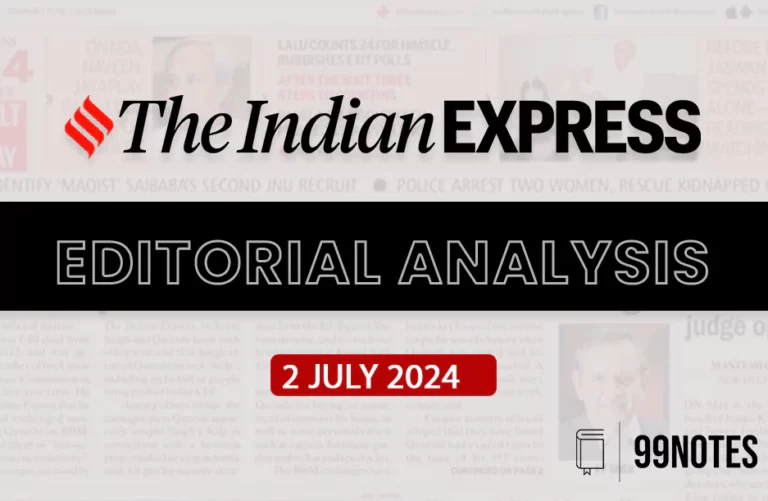5 March 2024 : Indian Express Editorial Analysis
Indian Express Editorial Analysis
5-March-2024
1. Let Pakistan be
| Topic: GS2 – International Relations – Bilateral Relations This topic is relevant for both Prelims and Mains as this article delves into the dynamics of bilateral relations between India and Pakistan, which is crucial for understanding the geopolitical landscape in South Asia. |
| Context: |
|
Bilateral Relations: Low Priority for India and Pakistan:
- Improving bilateral relations between India and Pakistan is not a pressing priority for either nation.
- Both Delhi and Islamabad view bilateral engagement as a high-cost, low-reward endeavor.
- Furthermore, the greater the ambition for fruitful bilateral relations, the higher the political costs associated with organizing such engagements.
- Pakistan, in particular, faces domestic challenges that weaken the new government’s ability to pursue ambitious diplomatic initiatives.
Modi’s Stance and India’s Priorities:
- Under Prime Minister Narendra Modi’s leadership, Pakistan has descended down the list of India’s foreign policy priorities.
- Modi has demonstrated India’s willingness to endure the freeze in bilateral relations and has effectively renegotiated the terms of engagement with Pakistan, which were established during a vulnerable period for India in the early 1990s.
Pakistan’s Stance and Obsession with India:
- In contrast, Pakistan remains fixated on India but has hindered progress with preconditions on engagement, particularly regarding the status of Kashmir.
- The insistence on rolling back the 2019 constitutional changes in Kashmir is deemed unrealistic by the Modi government, further complicating any potential resumption of talks.
Challenges in Normalizing Relations:
- Any positive movement in Pakistan regarding relations with India would require a departure from its fixation on Kashmir.
- However, this shift poses political challenges, especially amidst internal power struggles and the popularity of figures like Imran Khan, who advocate a hardline stance on Kashmir.
Economic Disparities and Reform Challenges:
- Pakistan also grapples with significant economic disparities compared to India, making it challenging to embark on substantial economic reforms.
- While Sharif acknowledges the need for reform, the government’s legitimacy and policy competence are questioned, hindering progress in this regard.
External Pressures and Geopolitical Realities:
- Pakistan faces external pressures from conflicting alliances, notably between China and the US, as well as evolving dynamics in the Gulf region.
- The changing geopolitical landscape adds to Pakistan’s challenges, necessitating internal reforms and external reorientation.
Conclusion:
- Given the multifaceted challenges facing Pakistan, including internal reform imperatives and external geopolitical pressures, immediate prospects for significant bilateral improvement with India appear limited.
- However, there may be opportunities for engagement based on evolving dynamics, including a potential shift in Pakistan’s perception of Indian leadership.
| About India-Pakistan relations |
|
| PYQ: Terrorist activities and mutual distrust have clouded India-Pakistan relations. To what extent the use of soft power like sports and cultural exchanges could help generate goodwill between the two countries? Discuss with suitable examples. (200 words/12.5m) (UPSC CSE (M) GS-2 2015) |
| Practice Question: How do the contrasting priorities and negotiating stances of the Modi government in India and the Sharif administration in Pakistan impact the potential for progress in bilateral relations, particularly concerning issues like Kashmir and economic reform? (250 words/15 m) |
2. Why minerals are critical
| Topic: GS1 – Geography – Distribution of Key natural resources GS2 – Governance – Government policies – Interventions for development in various sectors This topic is relevant for both Prelims and Mains in the context of understanding the significance of critical minerals and the regulatory framework governing their extraction. |
| Context: |
|
Definition and Significance of Critical Minerals:
- Critical minerals, while lacking a standardized definition, are identified by countries based on various criteria such as disruption potential, substitutability, cross-sectoral usage, import reliance, and recycling rates.
- It is crucial to distinguish between critical minerals and rare earths, as they serve diverse industrial purposes beyond decarbonization efforts.
Implications for Decarbonization and Industrial Sectors:
- Critical minerals play a vital role not only in decarbonization but also in various sectors such as fertilizers, construction, transportation, consumer electronics, and defense.
- Notably, clean energy technologies such as solar PV plants, wind farms, and electric vehicles require a significantly higher mineral input compared to fossil fuel counterparts, highlighting the growing demand for critical minerals in achieving climate goals.
Global Distribution and China’s Dominance:
- The distribution of critical minerals is concentrated among a few countries, with China, Australia, the Democratic Republic of Congo (DRC), and others controlling significant reserves.
- China stands out for its dominant position, controlling a substantial share of rare earth reserves and processing capacities, allowing it to exert influence over global supply chains.
Formation of Minerals Security Partnership (MSP):
- China’s monopoly on critical minerals has prompted concerns and led to the establishment of the US-led Minerals Security Partnership (MSP), aimed at securing critical mineral supply chains.
- India has joined the MSP, along with other countries possessing critical mineral deposits or processing technology.
- However, the effectiveness of the MSP may be limited by the exclusion of key mineral-rich countries like Chile, DRC, and Indonesia.
India’s Dependency and Plans for Decarbonization:
- India’s ambitious plans for decarbonization, aiming to achieve net-zero emissions by 2070 and set up 500GW of non-fossil fuel power generating capacity by 2030, underscore the importance of securing a steady supply of critical minerals.
- Currently, India heavily relies on imports for critical minerals, highlighting the need for exploration, processing capabilities, and technology access to support its decarbonization goals.
Challenges and Future Prospects:
- Despite efforts to secure critical mineral supply chains, challenges remain, including limited availability, processing capabilities, and geopolitical tensions.
- Lack of access to critical minerals poses a significant obstacle to India’s decarbonization efforts, emphasizing the need for strategic partnerships, technological advancements, and long-term planning to address these challenges effectively.
| About Mineral Security Partnership |
What are major critical minerals?
Who are the top producers of critical minerals?
What are rare earth elements?
|
| PYQ: Recently, there has been a concern over the short supply of a group of elements called ‘rare earth metals’. Why? (2012) 1) China, which is the largest producer of these elements, has imposed some restrictions on their export. 2) Other than China, Australia, Canada and Chile, these elements are not found in any country. 3) Rare earth metals are essential for the manufacture of various kinds of electronic items and there is a growing demand for these elements. Which of the statements given above is/are correct? (a) 1 only (b) 2 and 3 only (c) 1 and 3 only (d) 1, 2 and 3 Ans: (c) |
| Practice Question: Examine the geopolitical implications of China’s dominance in critical minerals production and processing, and India’s strategic responses, including its participation in the Minerals Security Partnership. (250 words/15 m) |
For Enquiry

5 March 2024 : Daily Current Affairs

5 March 2024 : Indian Express Editorial Analysis

5 March 2024 : PIB Summary for UPSC

5 March 2024 : The Hindu Editorial Notes PDF

Civil Disobedience Movement: Cause, Limitations, And Impact

Yojana Summary: January 2024 – Ease Of Doing Business

4 Mar 2024 : Daily Answer Writing

4 March 2024 : Daily Current Affairs

4 March 2024 : The Hindu Editorial Notes PDF

4 March 2024 : PIB Summary for UPSC
Daily Current Affairs 5 March 2024 : Daily Current Affairs Daily Current Affairs
5-March -2024- Top News of the Day
1. Supreme Court Challenges Parliamentary Privilege:…
Indian Express 5 March 2024 : Indian Express Editorial Analysis Indian Express Editorial Analysis
5-March-2024
1. Let Pakistan be
Topic: GS2 – International Relations…
March 2024 PIB 5 March 2024 : PIB Summary for UPSC PIB Summary for UPSC
5-March -2024
1. DefConnect 2024: Raksha Mantri launches ADITI scheme to promote…
March – The Hindu Editorial 5 March 2024 : The Hindu Editorial Notes PDF The Hindu Editorial
5-March-2024
1. World Trade Organization continues to struggle to foster free and…
general studies 1 Civil Disobedience Movement: Cause, Limitations, And Impact Civil Disobedience Movements:
Civil Disobedience Movement, one of the most pivotal episodes in India’s…
Yojana Summary Yojana Summary: January 2024 – Ease Of Doing Business Yojana Magazine Summary January 2024
Yojana magazine is monthly magazine published by government of India’s…
mains answer writing 4 Mar 2024 : Daily Answer Writing Mains Answer Writing
4-March-2024
Q1) “The Attorney General of India holds a pivotal position…
Daily Current Affairs 4 March 2024 : Daily Current Affairs Daily Current Affairs
4-March -2024- Top News of the Day
1. India’s Household Expenditure Survey…
March – The Hindu Editorial 4 March 2024 : The Hindu Editorial Notes PDF The Hindu Editorial
4-March-2024
1. Mountains of plastic are choking the Himalayan States
Topic:…
March 2024 PIB 4 March 2024 : PIB Summary for UPSC PIB Summary for UPSC
4-March -2024
1. The Union Ministry of Home Affairs releases three videos about…


